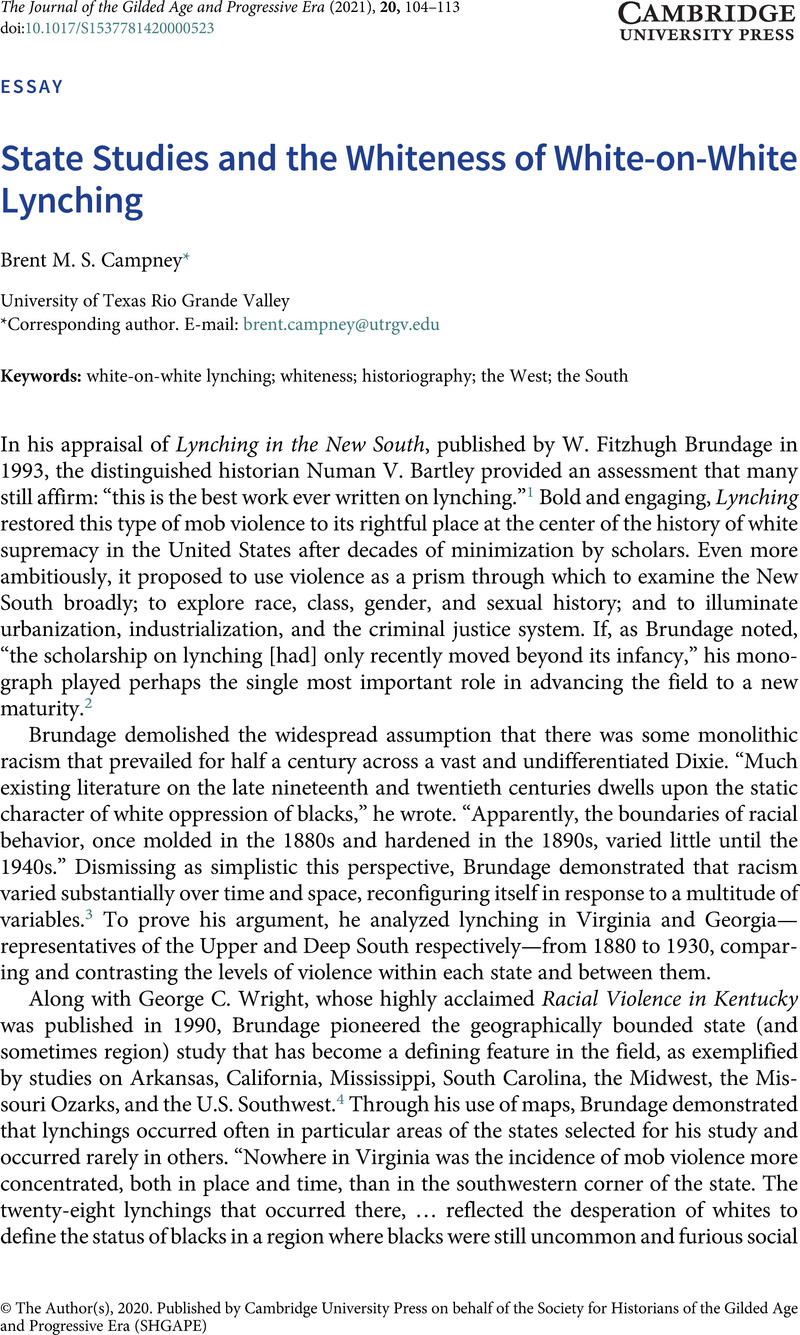No CrossRef data available.
Article contents
State Studies and the Whiteness of White-on-White Lynching
Published online by Cambridge University Press: 04 December 2020
Abstract

- Type
- Special Forum: Lynching in the New South A Quarter of a Century Later
- Information
- The Journal of the Gilded Age and Progressive Era , Volume 20 , Issue 1 , January 2021 , pp. 104 - 113
- Copyright
- © The Author(s), 2020. Published by Cambridge University Press on behalf of the Society for Historians of the Gilded Age and Progressive Era (SHGAPE)
References
Notes
1 Jacket blurb by Bartley, Numan V., from Fitzhugh Brundage, W., Lynching in the New South: Georgia and Virginia, 1880–1930 (Urbana: University of Illinois Press, 1993).Google Scholar
2 Brundage, Lynching in the New South, 8.
3 Brundage, Lynching in the New South, 13.
4 Wright, George C., Racial Violence in Kentucky, 1865–1940: Lynchings, Mob Rule, and ‘Legal Lynchings’ (Baton Rouge: Louisiana State University, 1990 [reprint: 1996]).Google Scholar A partial listing of geographically bounded studies includes Guy, Lancaster, Racial Cleansing in Arkansas, 1883–1924: Politics, Land, Labor, and Criminality (Lanham, MD: Lexington Books, 2014); Ken Gonzales-Day, Lynching in the West, 1850–1935 (Durham, NC: Duke University Press, 2006); Paul Ortiz, Emancipation Betrayed: The Hidden History of Black Organizing and White Violence in Florida from Reconstruction to the Bloody Election of 1920 (Berkeley: University of California Press, 2006); John Hammond Moore, Carnival of Blood: Dueling, Lynching, and Murder in South Carolina, 1880–1920 (Columbia: University of South Carolina Press, 2006); Brent M.S. Campney, Hostile Heartland: Racism, Repression, and Resistance in the Midwest (Urbana: University of Illinois Press, 2019); Beth Lew-Williams, The Chinese Must Go: Violence, Exclusion, and the Making of the Alien in America (Cambridge, MA: Harvard University Press, 2018); William D. Carrigan and Clive Webb, Forgotten Dead: Mob Violence against Mexicans in the United States, 1848–1928 (New York: Oxford University Press, 2013). Other such state and area studies are addressed below.Google Scholar
5 Brundage, Lynching in the New South, 143.
6 Brundage, Lynching in the New South, 191.
7 For the Baker quote, see https://www.press.uillinois.edu/books/catalog/64pct8rc9780252037467.html
8 Jacket blurb by Brundage, Fitzhugh, from Pfeifer, Michael J., Rough Justice: Lynching and American Society, 1874–1947 (Urbana: University of Illinois Press, 2004).Google Scholar
9 Pfeifer, Rough Justice, 3, 7.
10 Pfeifer, Rough Justice, 3, 7.
11 Brundage, Lynching in the New South, 2, 101.
12 Brundage, Lynching in the New South, 86.
13 Brundage, Lynching in the New South, 1.
14 Brundage, W. Fitzhugh, “Introduction,” in Under Sentence of Death: Lynching in the South, ed. Brundage, (Chapel Hill: University of North Carolina Press, 1997), 3, 4.Google Scholar
15 See Pfeifer, Michael J., The Roots of Rough Justice: Origins of American Lynching (Urbana: University of Illinois Press, 2011), 32; Pfeifer, The Roots of Rough Justice, 85.Google Scholar
16 Pfeifer, The Roots of Rough Justice, 51.
17 Pfeifer, The Roots of Rough Justice, 32. Pfeifer also writes that Black-on-Black lynchings were “nonracial.” See Roots, 85. For an alternative view, see Brent M. S. Campney, “Race Always Mattered: Black-on-Black Mob Violence and Inter-Racial Relations in Kansas,” American Nineteenth Century History 16:1 (Apr. 2015): 35–57.
18 See Pfeifer, The Roots of Rough Justice, 42, 67.
19 Brown, Richard Maxwell, Strain of Violence: Historical Studies of American Violence and Vigilantism (New York: Oxford University Press, 1975), 185, 95–97.Google Scholar
20 Beck, E. M. and Tolnay, Stewart E., “When Race Didn’t Matter: Black and White Mob Violence against Their Own Color,” in Brundage, Under Sentence of Death, 133, 136.Google Scholar
21 Beck, and Tolnay, , “When Race Didn’t Matter,” 132, 149.Google Scholar
22 Wright, Racial Violence in Kentucky, 127.
23 Leonard, Stephen J., Lynching in Colorado, 1859–1919 (Boulder: University Press of Colorado, 2002), 123.Google Scholar
24 Yost, quoted in Campney, Brent M. S., This Is Not Dixie: Racist Violence in Kansas, 1861–1927 (Urbana: University of Illinois Press, 2015), 84.CrossRefGoogle Scholar
25 Leonard, , Lynching in Colorado, 144, 127.Google Scholar
26 For a similar example of these tendencies, see Allen, Howard W. and Clubb, Jerome M., Race, Class, and the Death Penalty: Capital Punishment in American History (Albany: State University of New York Press, 2008), 132, 133.Google Scholar
27 Brown, , Strain of Violence, 96.Google Scholar
28 Allen, and Clubb, , Race, Class, and the Death Penalty, 129.Google Scholar
29 Hernando, Matthew J., Faces Like Devils: The Bald Knobber Vigilantes in the Ozarks (Columbia: University of Missouri Press, 2015), 6, 7.Google Scholar
30 Higgins, Cindy, “Frontier Protective and Social Network: The Anti-Horse Thief Association in Kansas,” Journal of the West 42 (Fall 2003): 63, 64.Google Scholar
31 Harper, Kimberly, White Man’s Heaven: The Lynching and Expulsion of Blacks in the Southern Ozarks, 1894–1909 (Fayetteville: University of Arkansas Press, 2010), xxii–xxiii.Google Scholar
32 Brundage, Lynching in the New South, 91–92.
33 Lipsitz, George, The Possessive Investment in Whiteness: How White People Profit from Identity Politics (Philadelphia: Temple University Press, 1998), 1.Google Scholar
34 Dirck, Brian R., Abraham Lincoln and White America (Lawrence: University Press of Kansas, 2012), 3.Google Scholar
35 Newitz, Annalee and Wray, Matthew, “What Is ‘White Trash?’ Stereotypes and Economic Conditions of Poor Whites in the United States,” in Whiteness: A Critical Reader (New York: New York University Press, 1997), 169.Google Scholar
36 Carrigan, William D., The Making of a Lynching Culture: Violence and Vigilantism in Central Texas, 1836–1916 (Urbana: University of Illinois Press, 2004), 81.Google Scholar
37 Waldrep, Christopher, The Many Faces of Judge Lynch: Extralegal Violence and Punishment in America (New York: Palgrave Macmillan, 2002); Lisa Arellano, Vigilantes and Lynch Mobs: Narratives of Community and Nation (Philadelphia: Temple University Press, 2012).CrossRefGoogle Scholar
38 Campney, This Is Not Dixie, 1.
39 All of this information derives from the author’s work in progress.
40 Campney, This Is Not Dixie, 52, 53. For a listing of anti-Black lynchings in Kansas, see Campney, This Is Not Dixie, Appendix 1, 220–38.


